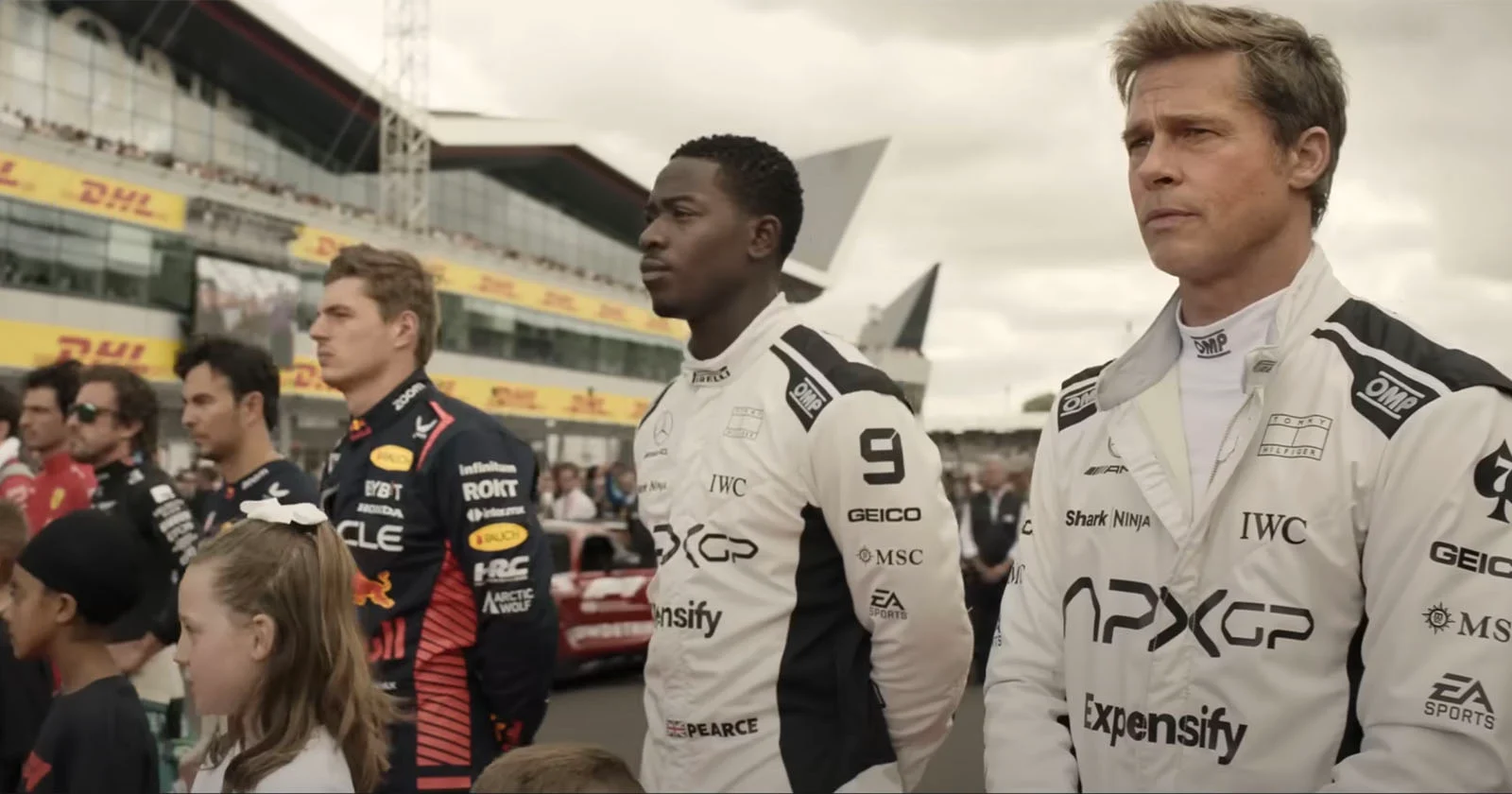I’ve never been a fan of Formula 1 or motorsports in general. I simply don’t have an interest in cars. That said, I’ve always had a technical curiosity about how things work – from the importance of soft or hard tires to the aerodynamics that turn race cars into real-life rockets. So, when I found out that Joseph Kosinski – the filmmaker behind Top Gun: Maverick – was directing F1, with Brad Pitt (Once Upon a Time in Hollywood) in the lead role and shot with IMAX cameras capturing real scenes during actual races, my love for cinema easily overrode my lack of interest in the sport. Add to that an appealing cast and Hans Zimmer (Dune: Part Two) composing the score, and there was no way I could ignore one of the year’s biggest blockbusters.
F1 then sees Kosinski at the wheel, known for his innovative approach to filming action with practical and immersive camera work, and written by Ehren Kruger (also Top Gun: Maverick). The story centers on Sonny Hayes (Pitt), a former driver returning to the circuit as a racing partner to Joshua Pearce (Damson Idris), a young rising star racing for the fictional team APXGP. With Kerry Condon (The Banshees of Inisherin) as the team’s chief engineer and Javier Bardem (Dune) as the team’s owner, the film plunges into the world of Formula 1 with an incredibly immersive perspective.
Let’s start with what everyone wants to know: how are the race sequences? Kosinski, along with longtime cinematographer Claudio Miranda, literally puts the audience inside the car. Using IMAX cameras mounted on real vehicles – just like with the jets in the Tom Cruise-led aerial epic – often during official practice sessions, F1 delivers a visceral, raw, hyper-realistic experience. The feeling of speed, the G-forces in the turns, the tension of every millisecond – all of it is captured so intensely that it’s nearly impossible not to hold your breath during the most thrilling sequences. This is action filmmaking in its purest form, and in that regard, the blockbuster sets a new standard.
Zimmer delivers yet another memorable score, filled with pulsating themes that fuel the adrenaline of the races but also dial back for more intimate moments, especially in the final act. The last few tracks that accompany the climax pack an unexpectedly emotional punch, even if the narrative doesn’t always rise to the same epic heights as the music. The editing, by Stephen Mirrione (Birdman), is another standout. There’s an enviable fluidity in how Mirrione balances the racing scenes with the behind-the-scenes segments, never losing pace, even when the screenplay ventures into more conventional territory. In fact, the collaboration between editing and cinematography results in one of the most visually and rhythmically cohesive movies of the year.
As expected, the cast is top-tier. Pitt, now 61, throws himself physically into a demanding role, and the chemistry he shares with Idris (Outside the Wire) and Condon is, without a doubt, the emotional anchor of the story. Hayes and Pearce may seem very different – one’s a skeptical, seasoned veteran, the other a young, ambitious, and somewhat naive talent – but they both exude the same level of arrogance and self-confidence.
Their shared arc of mutual growth is well-handled, despite some slightly forced narrative choices – a 10 to 15-minute block following a key moment includes character decisions and plot developments that feel extremely hard to buy. Still, their relationship remains compelling and full of its own unique humor. Unfortunately, this segment disrupts the emotional coherence and raises questions that F1 never really answers, including the complete dismissal of a major plot point.
Condon shines as the engineer holding the team together, offering a charismatic, authentic performance. However, the attempt to develop a romance between her character and Pitt’s feels inorganic and even detracts from the female character’s individual achievements as a woman in a male-dominated sport. It also contributes to a bloated runtime that could have been trimmed. The same goes for the subplot involving corporate and marketing interests – topics that do have potential but are treated in a shallow, stereotypical manner, ultimately adding little to the main story and offering no real commentary on the commercialization of the sport.

Where F1 truly stands out is in how it communicates an aspect often ignored by casual observers: Formula 1 is not an individual sport. It’s a team effort. A fantastic driver with a mediocre car doesn’t win races, just as a great car is useless without a competent driver. Moreover, behind every race is a massive team – engineers, strategists, mechanics – all working with equal intensity. Kosinski and Kruger do an outstanding job of showing how every tenth of a second is earned by a group, not just one person. This message is reinforced throughout, especially in scenes that highlight pit work, strategy sessions, and the sacrifices of everyone involved. This is where the film finds its heart: not in the glory of the podium, but in the shared, often silent effort that makes it possible.
For those, like me, who don’t follow the sport, F1 offers some accessible explanations of Formula 1’s technical elements. Still, I felt there was room for more depth – especially since the movie doesn’t shy away from certain jargon that might confuse the uninitiated. That said, the balance between accessibility and verisimilitude is handled reasonably well.
The script doesn’t avoid clichés. Its trajectory is predictable – the reluctant veteran, the brash rookie, redemption through teamwork – but it never becomes dull. There’s an emotional honesty to the characters, a clear respect for the sport, and a structural cohesion that makes the over-two-hour runtime fly by. Even with some unnecessary narrative detours, the overall experience is so absorbing that its flaws carry little weight in the end.
As for Formula 1 fans, there’s certainly added value: cameos from real-life figures in the sport, references to actual circuits and teams, and audiovisual capture that – even when similar to what’s seen in TV broadcasts – is elevated to a higher immersive level by the cinematic scale. But F1 is, above all, a film made for everyone – even those with zero interest in the sport.
F1 is a technical and sensory triumph, a cinematic rollercoaster that throws viewers right into the heart of the action with rare intensity. Despite some narrative stumbles and a familiar structure, Joseph Kosinski’s creatively bold and technically dazzling vision, Hans Zimmer’s electrifying score, and a fully committed cast turn this blockbuster into one of the most exhilarating, high-energy experiences of the year. Whether you’re a diehard fan or just a curious spectator, this movie races straight into the heart of spectacle cinema – with style, tension, and, of course, a whole lot of speed.





